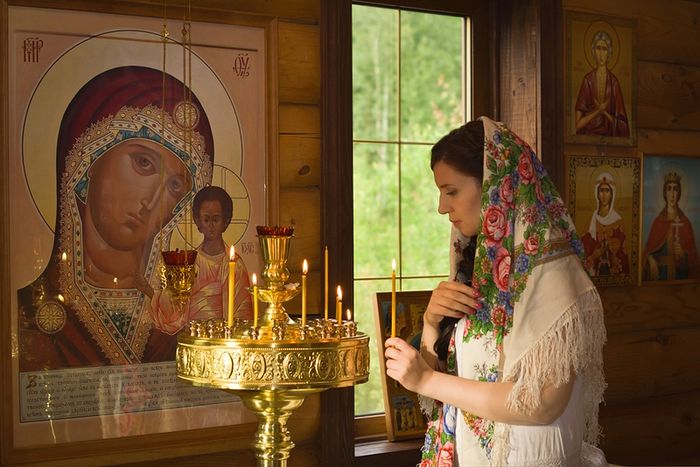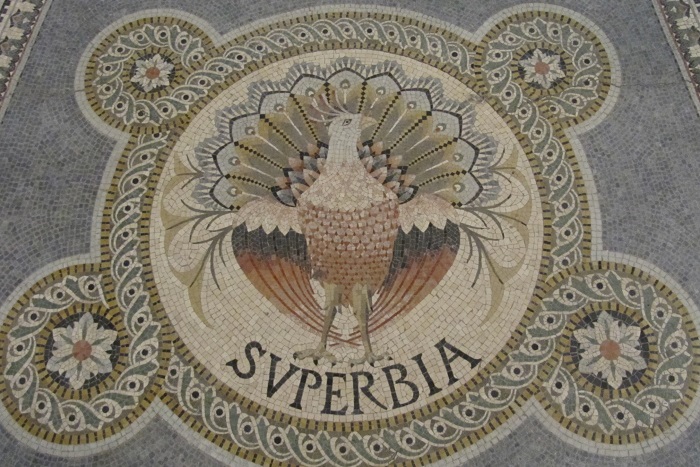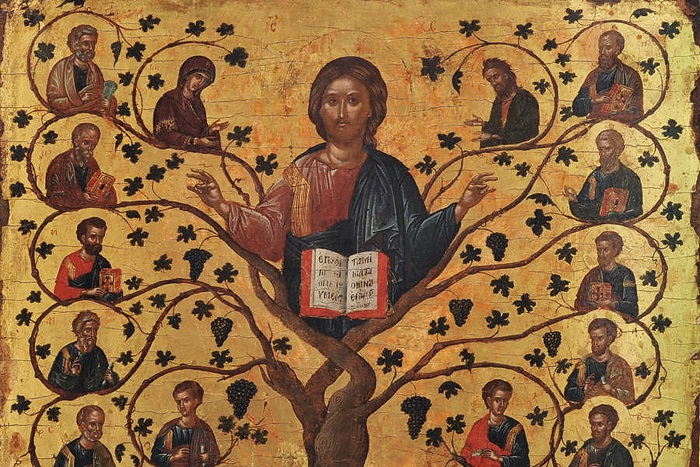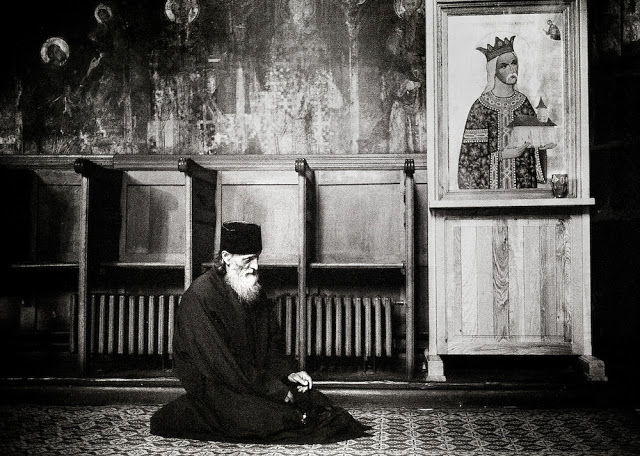
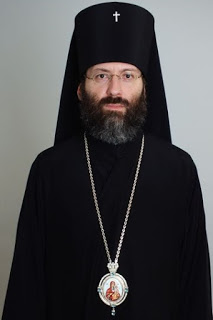
Professor Archimandrite Job Getcha traces the origins and development of Russian monasticism, showing how both its roots and its spirituality are firmly based in the Byzantine Hesychast tradition, and highlighting the particular importance of the Athonite influence. Rather than being a poor cousin of the Byzantine monastic tradition, the Russian monastic tradition has, from the very beginning, been a part of it, bringing forth its own great scholars and ascetics.
I will begin my presentation on Russian monastic spirituality by telling an anecdote. It is said that when Fr. Basil Zenkovsky defended his doctoral dissertation on ‘The history of Russian philosophy’ at St. Sergius’ Theological Institute in Paris, Fr. George Florovsky made the objection that there is no such concept as ‘Russian philosophy’. Fr. Basil replied to his opponent saying: “I am thankful to Fr. George for his remark, which I receive with great respect. Nevertheless, I do not understand how Fr. George himself could be the author of a book entitled ‘The ways of Russian theology’”.
The same can be said about the Russian monastic tradition. It is not Russian at all. Its roots are deeply Byzantine. Its spirituality is impregnated by the Hesychast tradition, which summarises the monastic experience in the deserts of Egypt, Palestine, Cappadocia and Syria. From its origins, it is tightly linked with Mount Athos, the heart of spiritual life of the Orthodox Church and the only monastic republic of the world.
We will therefore start our survey of the Hesychast spirituality of the Russian monastic tradition by recalling the genesis of monasticism in Kievan Rus’. We will then focus on the golden age of Hesychasm in Russia, and finally, we will speak of the renewal of Hesychasm in the XVIIIth century and its impact of Russian monasticism.
The Kiev Caves Monastery
The baptism of Kievan Rus’ in 988 marks the beginning of a new period of history of the Russian people. Kiev, the mother of Russian cities, will reflect in the former barbarian state the glory and splendour of Constantinople. The choice taken by the Great Prince Vladimir will crown Kievan Rus’ with the Byzantine culture and Greco-Roman civilisation of the Mediterranean World. This can appear clearly not only in religious matters, but as well in the art, the literature, the law and the architecture. Like Constantinople, Kiev will be put under the protection of the Mother of God and will be adorned with the Great Church of the Wisdom of God — Saint Sophia.
If the capital of Xth century Kievan Rus’ was modelled after Constantinople, its first largest monastery was modelled after Mount Athos and Byzantine Hesychasm. When Saint Anthony, the founder of Russian Monasticism, came back to Kiev, and established himself in a tiny cave where previously a pious priest named Hilarion, who became by that time Metropolitan of Kiev, used to seclude himself for ascetic labours, living the life of a Hesychast, Anthony brought with him the blessing of the Holy Mountain which he sowed in the ground where the great Lavra of the Kiev Caves ought to flourish. “Anthony”, his geronda told him, “go to Russia, in order to become there an example and a guide for your people. May the blessing of the Holy Mountain be with you!”

By that time, Mount Athos had become not only the refuge of monks fleeing Persian and Arabic invasions, but had appeared as the continuation of the great deserts of Egypt, Palestine and Syria. The monastic lifestyle of the kelliots of Saint Sabas Monastery, having been inspired by the organisation of monasticism of Nitria, had been transposed to Athos since the arrival of the first monks on that paradisiacal peninsula. Thus, it was through the Holy Mountain that the first Russian monasticism was linked to the great monastic tradition of Egypt, Palestine, Cappadocia and Syria. Indeed, the first monks of the Kievan Caves not only took the names of the ancient Fathers of these deserts but also followed their lifestyle, which they considered as their model.
Reminiscent of the spiritual anecdotes of Apophtegmata Patrum, of the Historia Lausiaca of Palladius or the Spiritual Meadow of John Moschus, the Paterikon of the Kiev Caves appears as an edifying book, transmitting a spiritual message and teaching, rather than a historical or biographical work. The Paterikon insists on demonology and miracles, and here one can notice that the Vita Antonii of Athanasius of Alexandria was perhaps one of the major sources of inspiration of the Paterikon. Written around 1215 by Bishop Symeon of Vladimir and his friend, the monk Polycarp, at the peak of the spiritual flourishing of the Kiev Lavra, the Paterikon put into a written form an oral tradition which was latter amplified in the XIVth century with some mystical flavour.
It recalls the story of the foundation of the monastery, which was organised following the lavratic system where a cenobite monastery, the centre of formation for novices, is surrounded by hermits cells. Indeed, desiring to live a more secluded life, Saint Anthony left his initial cave where several novices had come, leaving them under the spiritual care of Saint Barlaam, and settled in another empty cave. When Barlaam was appointed hegumenos of another monastery, Saint Theodosius became his successor at the head of the monastery of the caves. It was under his direction that the monastery developed. For his cenobium, he used the Studite Typikon of Patriarch Alexis, the liturgical and monastic rule observed in most Byzantine coenobite monasteries of that time. This Typikon regulated the liturgical services as well as the private prayer of the monks, their meals, and their duties. Theodosius is thus considered as the founder of coenobite life in Russia. By his own example, Theodosius emphasised not only the spiritual aspects of ascetic life, but also the necessity for physical work and charity to the poor.
Quite soon, because of the great number of the brethren and thanks to generous donations, buildings were constructed over the initial caves for the coenobite monastery, as well as a katholikon in honour of the Dormition of the Mother of God. Nevertheless, the caves were still used as dwelling places for recluses, hermits, for prayer, as well as for funerary purposes. The monastery received the name of ‘Lavra’ because it followed the lavratic system inherited from Palestine through Mount Athos. Since it was settled in the caves on the bank of the Dniepr River, the Lavra was therefore called ‘of the Kiev Caves’. The monastery had a hospital which took care of the ill as well as a guest house to receive pilgrims and the poor, who were fed, serving in this way the newly Christianised society in humility and charity.
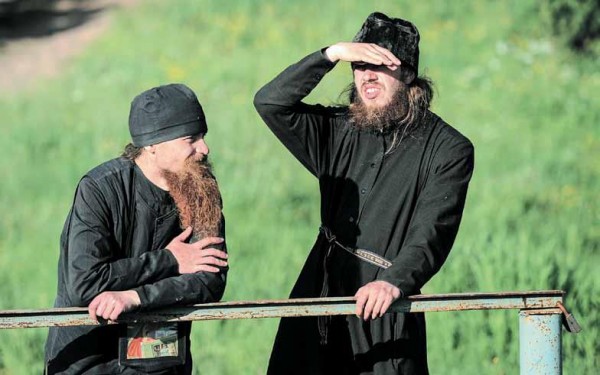
Among the various developed themes, the Paterikon insists on the necessity of prayer, of fasting, of spiritual discernment in order to avoid spiritual illusion, of love, of forgiveness, of humility. As in the classical ascetic literature, monastic life is presented as a spiritual warfare with demons, and ascetic life aimed at healing the major passions (gluttony, fornication, cupidity, anger, sadness, depression, vainglory and pride). In order to teach this, the Paterikon tells us many entertaining stories which have many parallels in the Vita Antonii. As in the Ladder of Saint John Climacus — the great Byzantine monastic classic — it presents monastic life as purification of the body and of the soul, deep humility and total obedience, a life of free renunciation and poverty, of severe fasting, sleepless vigil and unceasing prayer (cf. 1 Thess 5:17). In fact, the practice of the Jesus Prayer is attested literally by the Paterikon in the life of Saint Nicholas Sviatocha, thus testifying that the spirituality of Kievan Rus’ was indeed rooted in Byzantine Hesychasm.
Some present Russian monasticism as rather simple and uneducated, while they describe Greek monasticism as more intellectual, more erudite. This does not seem to be true. From its beginning, the Kiev Caves Lavra appears to be not only a place of ascetic labours but also a centre of learned monasticism. One can read the most famous homilies of that time, the Discourse on Law and Grace, written by the first native Metropolitan of Kiev, Hilarion, who appears also as the first Russian Hesychast and who later retired in the Lavra. This pearl of early Russian literature, composed as an Encomium in honour of Saint Vladimir, the ‘Apostle’ of the Russian people, having dissipated the darkness of idolatry and enlightened his land with the light of the Gospel, is a rather long homily pondering on the essence of the New Covenant and the Divine economy. It shows such a deep knowledge of Byzantine theology, exegesis and rhetoric that it could not have been written by an illiterate monk. This is even more remarkable considering that Hilarion is regarded not as a Greek, but as the first native metropolitan.
A monk of the Lavra described by the Paterikon, Nestor the Chronicler, is considered as the first Russian historian and the protector of learned monasticism. According to the Paterikon, he came to the Lavra at the age of 17, and was revealed by God as the chronicler who had put into a written form the history of the Russian land and the foundation of the Kiev Caves monastery. His story brings therefore a testimony to the fact that the Kiev Caves Lavra was a centre of science and education. Indeed, Nestor’s Chronicle of Ancient Times remains until now the major source of ancient Russian history.
The authors of the Paterikon, Symeon and Polycarp, show in their writings a deep knowledge of the greatest classics of Byzantine monastic literature, which was not only translated but read and assimilated as well. We know, for instance, that the Vita Antonii, the Ladder of Saint John Climacus and the writings of Saint Ephrem the Syrian were among the patristic works which were translated and read in Kievan Rus’. Thus, the phenomenon of learned monasticism is not only a characteristic of Byzantine monasticism, but was also present in Russian monasticism from the very beginning.
This fascinating period of ‘Kievan byzantinism’ came to an end in 1240, when Kiev was destroyed by the invasion of the Tatar Khan Baty. Monks had to flee and find refuge in other places. Some of the monks of the Kiev Caves Lavra went to the West and settled on the Pochaev hill where a large monastery flourished in the XVIth century. Others fled to the North, leading to another chapter of Russian monasticism.
The Golden Age of Russian Hesychasm
The XIVth century was a century of great paradox both in Russia and Byzantium. Although both were struggling in a political instability — Byzantium with the Ottoman empire, Russia with the Golden Horde — it was nevertheless a very bright moment in history where theology and liturgy were the spiritual light that enlightened the darkness of everyday life. Once again, Mount Athos, the spiritual centre of the Orthodox world, played a very important role.
Cyprian of Kiev
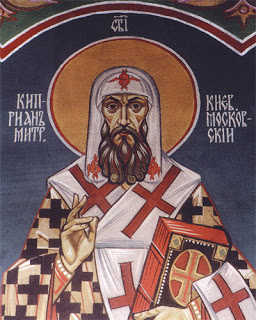 Known as the ‘Metropolitan-liturgist’, Cyprian Tsamblak should be seen as the bridge between Russia and Byzantium. He was born around 1330 in the region of Trnovo in Bulgaria. He can be considered as the disciple or even as the spiritual son of the Palamite monk Philotheos Kokkinos, who first became hegumenos of the Great Lavra on Mount Athos and later Patriarch of Constantinople (1353-1354, 1364-1376). Closely linked to this major figure of XIVth century Byzantine hesychasm, Cyprian lived on Athos in his youth where he was initiated into the dogmatic and spiritual teaching of Saint Gregory of Sinai and Saint Gregory Palamas and acquainted with the Typikon of Jerusalem (of Saint Sabas Monastery), having influenced worship on the Holy Mountain. Later, he was sent to Russia by his spiritual father, Patriarch Philotheos, and appointed Metropolitan of Kiev and Lithuania (in 1375), and later, as Metropolitan of Kiev and all Russia (1381-1382, 1390-1406).
Known as the ‘Metropolitan-liturgist’, Cyprian Tsamblak should be seen as the bridge between Russia and Byzantium. He was born around 1330 in the region of Trnovo in Bulgaria. He can be considered as the disciple or even as the spiritual son of the Palamite monk Philotheos Kokkinos, who first became hegumenos of the Great Lavra on Mount Athos and later Patriarch of Constantinople (1353-1354, 1364-1376). Closely linked to this major figure of XIVth century Byzantine hesychasm, Cyprian lived on Athos in his youth where he was initiated into the dogmatic and spiritual teaching of Saint Gregory of Sinai and Saint Gregory Palamas and acquainted with the Typikon of Jerusalem (of Saint Sabas Monastery), having influenced worship on the Holy Mountain. Later, he was sent to Russia by his spiritual father, Patriarch Philotheos, and appointed Metropolitan of Kiev and Lithuania (in 1375), and later, as Metropolitan of Kiev and all Russia (1381-1382, 1390-1406).He was in contact with the great Russian ascetic of that time, Saint Sergius of Radonezh. We have a correspondence between them, where Cyprian tells Sergius about his struggle to reach his throne in Moscow against the will of the Great Prince Dimitri Donskoj. In one of these letters, Cyprian states that he is seeking neither glory nor wealth, but the metropolis that has been entrusted to him by the Great Church of Constantinople.
Once established in Moscow, Cyprian visited many times the Kiev Caves Lavra, which was being rebuilt after its destruction by the Tatars. Although he was a bishop in a tumultuous period of history, he was seeking a Hesychast life-style. The experience that he had had as a young monk on Mount Athos among the hesychasts had determined in him a deep desire for secluded life, for prayer and study, which he achieved in his hermitage in the village of Golenischevo, near Moscow. Being also a greatly erudite man, he installed a scriptorium where, with the help of copyists, he copied and translated patristic and liturgical manuscripts. Historians have attributed to him translations of the Corpus Areopagiticum and the Ladder of St. John Climacus, although recent studies seem to point out that Cyprian would have only copied existing translations.
His major achievement was definitely the liturgical reform he inaugurated, following the model of the reform Patriarch Philotheos had previously achieved in Byzantium. This reform consisted in the introduction of the Typikon of Saint Sabas. It was not just merely a textual reform, like the one of Patriarch Nikon in the XVIIth century, but a reform that changed profoundly the liturgical habits of both monasteries and parochial churches. The Typikon of the Great Church, used in parochial churches, as well as the Typikon of Alexis the Studite, used in monasteries, were both replaced by the Typikon of the Lavra of Saint Sabas in Palestine, thus leading towards the introduction of a unique Typikon for both parishes and monasteries, and towards a synthesis of both monastic and parochial liturgical traditions. This Typikon of Saint Sabas was already in usage by that time on Mount Athos and was therefore propagated everywhere in the Byzantine world by the Hesychasts.

Cyprian is the author of the famous ‘Answers to Hegumenos Athanasios’, a disciple of St. Sergius of Radonezh and hegumenos of the Vysotsky Monastery in Serpukhovo, founded by St. Sergius in 1374. Athanasios was later the editor of the first Russian Sabaite Typikon. In these ‘Answers’, Cyprian tells Athanasios to read the Paterikon, the works of St. Ephrem the Syrian, of St. Dorotheos of Gaza as well as the Hexameron of St. Basil the Great in the refectory of his monastery. This shows, once again, the interest, the culture as well as the erudition of the Russian monks who were disciples of the Byzantine Hesychasts.
Through his broad pastoral activity, Metropolitan Cyprian makes the link between XIVth century Russia and the great Byzantine Hesychast tradition summarised by St. Gregory of Sinai and St. Gregory Palamas. One of the major and essential aspects of their spirituality is the universality of prayer. For them, the commandment of St. Paul: “Pray without ceasing” (1 Thess. 5:17) has to be applied to every Christian without any exception. Cyprian’s mentor, Patriarch Philotheos, in his Life of St. Gregory Palamas, says that this saint taught “that not only we, [the monks], ought to pray without ceasing, but had to teach this also to all the others — to the monks and laymen, to the wise and to the ignorant, to men as well as to women and children, and to exhort them to pray always”. Therefore, it appeared to the Hesychasts of that period that there were not two kinds of spirituality, one for the monastic and another for the laity, nor two kinds of worship, but only one, since prayer was a universal and essential part of Christian life of both the laity and the monastic.
We often think that the life of the hesychasts as consisting essentially in the practice of the Jesus Prayer, which they preferred rather than liturgical services. But
this image does not reflect the true reality. If one reads in the writings of St. Gregory of Sinai his description of the day of a monk on Mount Athos, it will appear obvious that its rhythm was set by the liturgical services of the Horologion, the reading of the Psalter, Jesus prayer and work. The teachings of St. Gregory of Sinai, as well as the teaching of the Hesychast Patriarchs Kallistos and Ignatios Xanthopouloi, remind us the origins of the Horologion as the rule of psalmody (kanôn tês psalmôdias) which the monks of Palestine ought to accomplish every day. The Vita of Saint Sabas tells us that novices at the Lavra of Saint Sabas in Palestine had to learn this rule of prayer by heart as well as the entire Psalter when entering the monastery. The Horologion was therefore the only liturgical book used daily for their rule of prayer, even when travelling. In a letter attributed to Patriarch Euthymios of Trnovo, written to the young monk Cyprian who was at that time on Mount Athos, we read: “Do not neglect to sing matins, the hours, vespers as well as compline, and with them, the midnight service, since they are powerful weapons of the soul against the enemies”. Therefore, it is not surprising that the liturgical reform of Metropolitan Cyprian was undertaken by editing an Horologion — a copy of which has been carefully kept until our days in the Holy Trinity Lavra near Moscow.
this image does not reflect the true reality. If one reads in the writings of St. Gregory of Sinai his description of the day of a monk on Mount Athos, it will appear obvious that its rhythm was set by the liturgical services of the Horologion, the reading of the Psalter, Jesus prayer and work. The teachings of St. Gregory of Sinai, as well as the teaching of the Hesychast Patriarchs Kallistos and Ignatios Xanthopouloi, remind us the origins of the Horologion as the rule of psalmody (kanôn tês psalmôdias) which the monks of Palestine ought to accomplish every day. The Vita of Saint Sabas tells us that novices at the Lavra of Saint Sabas in Palestine had to learn this rule of prayer by heart as well as the entire Psalter when entering the monastery. The Horologion was therefore the only liturgical book used daily for their rule of prayer, even when travelling. In a letter attributed to Patriarch Euthymios of Trnovo, written to the young monk Cyprian who was at that time on Mount Athos, we read: “Do not neglect to sing matins, the hours, vespers as well as compline, and with them, the midnight service, since they are powerful weapons of the soul against the enemies”. Therefore, it is not surprising that the liturgical reform of Metropolitan Cyprian was undertaken by editing an Horologion — a copy of which has been carefully kept until our days in the Holy Trinity Lavra near Moscow.
Besides the liturgical services, hesychasts emphasised the importance of frequent communion. In the letter attributed to Patriarch Euthymios of Trnovo, written to the young monk Cyprian, the ancient practice in Palestinian monasticism of self-communion in kellia is being raised. Although Euthymios states clearly that monks should attend regularly the Divine Liturgy and receive communion in the monastery church, nevertheless, if, due to illness, monks cannot attend it, or, if they are living faraway from a church with a priest, they can administer Holy Communion to themselves after having read the proper prayers. The same emphasis on frequent communion is also attested in the writings of the Hesychast Patriarchs Kallistos and Ignatios Xanthopouloi, which are found in the Philokalia. These authors considered that frequent communion to the Divine mysteries was beneficial for the purification of the soul, illumination of the intellect, sanctification of the body and remission of sins, and that, therefore, monks ought to prepare themselves for receiving holy mysteries every day.
Sergius of Radonezh
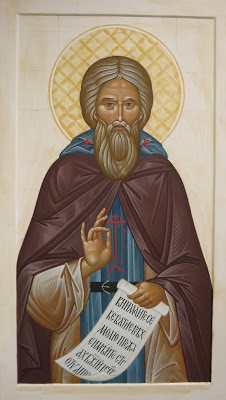
The history of the Holy Trinity Lavra, founded in 1337, is of course tightly linked with the figure of St. Sergius of Radonezh (1314-1392). The Vita of St. Sergius, written by his disciple, Epiphanius, surnamed the Wise, was written in a style that recalls by its miracles and demonology the Paterikon of the Kiev Caves, especially the Vita of St. Theodosius, and its major source, the Vita Antonii by St. Athanasius the Great and other great classics of Byzantine ascetic literature. Born in Rostov into a boyar family, the young Bartholomew moved with his parents to Radonezh nearby Moscow, due to the frequent inroads of the Tatars. The Vita presents his childhood with a catalogue of Christian virtues: stillness, meekness, silence, humility, wrathlessness, simplicity, equal love to all men. It presents him as a contemplative child, lover of solitude, prone to tears and loving to recite the Psalter, which he knew by heart. As a young man, he settled with his brother Stephen in the forest not faraway from Radonezh — in the place which would later become the great Lavra — taking over the anchorite tradition of ancient monasticism. Reproducing the portrait of St. Anthony the Great, his hagiographer presents him as frequently attacked and intimidated by terrifying demons. Epiphanius also presents fasting as the only ascetic weapon in struggle with fleshly temptations.
Sergius received the monastic tonsure at the age of 24 from the hands of the hegumenos Metrophanes. Imitating the ancient desert Fathers, Sergius did not want to be ordained a priest. And here appears in the Vita of St. Sergius the importance of the liturgical services and frequent eucharistic communion in the life of the Russian monks. The different canonical hours could have been celebrated without a priest, but not the Divine Liturgy. After the death of Metrophanes who was a priest, the brethren who were twelve by that time, insisted that Sergius should become their superior and their priest: “We wish to come to you for confession and to see you celebrating the Divine Liturgy every day, and to receive communion from your venerable hands”. Sergius refused, saying that it was better for him to weep for his own sins, but he finally accepted and was ordained priest and hegumenos. Nevertheless, this did not change his humble lifestyle based upon the imitation of the humiliated Christ. This extreme humility led Sergius to renounce the episcopal consecration that was proposed to him by Metropolitan Alexis, who presented him with his own golden pectoral cross: “Forgive me, my lord — said Sergius to the Metropolitan — from my youth I never wore gold, and in my old age I wish even more to live in poverty”.
Prof. Fedotov liked to speak of the kenotic ideal of Russian monasticism, which was of course incarnated by St. Sergius as well as many other Russian saints. This also recalls the way St. Theodosius used to administrate the Kiev Caves Lavra. The miracle of the loaves of bread which were sent by the Divine Providence through an unknown benefactor after the prayer of Sergius when his brethren were starving reminds us of a similar episode in the Vita of St. Theodosius in the Kiev Caves Paterikon while teaching us about Christian patience and hope. We can see many other similar episodes speaking of simplicity, openness, humility and charity between the lives of St. Sergius and St. Theodosius, the founder of Russian coenobitism, modelled after the Studion of Constantinople. As Prof. Fedotov has pointed out, “the model of Theodosius is manifestly reflected in him (Sergius), only more refined and spiritualized”.
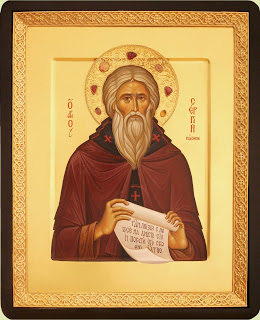
We read also in the Vita that St. Sergius was blessed by the Patriarch Philotheos (Kokkinos) of Constantinople who had heard about him and sent him a letter asking him to follow the coenobite rule in his monastery. To encourage him in his further ascetic labours, Patriarch Philotheos had also sent him a cross and many other gifts.
The Vita of St. Sergius does not credit him with scholarship. He is not presented as a writer. The Vita even recalls the miraculous gift of learning which he received in his childhood through eating a piece of prosphora presented to him by an elder. Nevertheless, St. Sergius popularised among his disciples the great Byzantine Hesychast legacy, inheriting the best monastic traditions of Mount Athos and Sinai through the teachings of St. Gregory Palamas and St. Gregory of Sinai. Among his disciples, the future hegumenos Athanasios of the Vysotsky Monastery, spent twenty years in Constantinople to study and copy manuscripts. His other disciple and hagiographer, Epiphanios the Wise with Pachomios Lagothet undertook a considerable hagiographic edition. Soon, the library of Holy Trinity Lavra contained translations of St. Gregory of Sinai dating to the XIV-XV centuries as well as translations of the works of St. Symeon the New Theologian — both great classics of Byzantine Hesychast literature. Thus, Sergius had rooted the spiritual life of his disciples in the great heritage of Byzantine Hesychasm.
The Northern Thebaid
Sergius had a great impact on monastic life in Russia. Besides the Holy Trinity Lavra, he founded many other monasteries. Eleven of his disciples also became founders of monasteries, most of them while Sergius was still alive. They carried the spiritual legacy of St. Sergius to all the corners of Russia, particularly in Northern Russia which has been surnamed by A. Muravev the ‘Russian Thebaid’. The monasticism of this period is different from that of ancient Russia: it is a monasticism of the ‘desert’. With the destruction of the urban monasteries during the Mongol invasions, it became obvious for the monks to seek refuge in virgin forests where they could live in the classical tradition of the desert monasticism of Egypt, Palestine and Syria.
 The figure of Cyril of Belozersk, who did not belong to Sergius’ immediate disciples, was a real link between Sergius and the Northern monasticism. Besides obedience and patience, the gift of tears — “umilenie” – a characteristic of the Syrian monastic tradition, was among his numerous virtues. With Ferapont, a monk of the Simonov Monastery, he travelled from Moscow to the North, to the region of the White Lake, and founded a monastery. There, particular attention was paid to celebrate the divine services according to the Sabaite Typikon introduced in Russia by Metropolitan Cyprian. Ferapont founded also his own monastery nearby Cyril’s monastery. It became famous because of the frescoes made by the master Dionysios. Around the big monasteries, groups of cabins (sketes) were built where anchorites lived in silence and extreme poverty, thus keeping faithfully the ancient Palestinian and Athonite monastic tradition.
The figure of Cyril of Belozersk, who did not belong to Sergius’ immediate disciples, was a real link between Sergius and the Northern monasticism. Besides obedience and patience, the gift of tears — “umilenie” – a characteristic of the Syrian monastic tradition, was among his numerous virtues. With Ferapont, a monk of the Simonov Monastery, he travelled from Moscow to the North, to the region of the White Lake, and founded a monastery. There, particular attention was paid to celebrate the divine services according to the Sabaite Typikon introduced in Russia by Metropolitan Cyprian. Ferapont founded also his own monastery nearby Cyril’s monastery. It became famous because of the frescoes made by the master Dionysios. Around the big monasteries, groups of cabins (sketes) were built where anchorites lived in silence and extreme poverty, thus keeping faithfully the ancient Palestinian and Athonite monastic tradition.In the Vologda region, in the Komela forest, monasteries were founded by Paul of Obnora and Sergius of Nuroma, Sergius’ disciples, who called silence the mother
of all virtues. Another monastery was built on the Kuben Lake by a monk who came there from Mount Athos. The island of Solovki in the White Sea became the famous monastic centre of Northern Russia as well, with its establishment by Zosima and Savvatius. In the region of Novgorod, Sabas of Vishera founded his monastery.
of all virtues. Another monastery was built on the Kuben Lake by a monk who came there from Mount Athos. The island of Solovki in the White Sea became the famous monastic centre of Northern Russia as well, with its establishment by Zosima and Savvatius. In the region of Novgorod, Sabas of Vishera founded his monastery.
Poverty was considered as one of the main monastic virtues. It was also a way of life allowing independence toward the civil authorities. Exterior asceticism was nevertheless subordinated to an inner one, to “spiritual working” consisting in the purification of the mind and union with God in prayer. This activity corresponded obviously to the “mental prayer” practised by the Byzantine Hesychasts and which was fully developed in Russia by Nilus Sorski (1433-1508).
We do not know much about Nilus’ biography. We only know that he became a monk “in his youth” and that he visited both Constantinople and Mount Athos, where he was initiated into “mental prayer”. The greatest merit of Nilus’ for Russian monasticism was the compilation of an anthology of ascetic writings which was the anticipation of the XVIIIth century Philokalia. Among the writers selected by Nilus for his anthology we find: Basil the Great, Macarius of Egypt, John Cassian, Nilus of Sinai, Dorotheus, John and Barsonophius of Gaza, John Climacus, Maximus the Confessor, Isaac the Syrian, Symeon Stethatus, Philotheus of Sinai, Peter Damascene and Gregory of Sinai. He is also credited in Russia with founding the lifestyle of sketes, an intermediary way of life, between coenobitism and heremitism, which was very popular on Mount Athos at that time.
The treatise of Nilus was in fact in Russia the first summary of the ascetic doctrine of the ancient Fathers. From Hesychius of Sinai, Nilus borrowed the five stages of sin: the appearance of a thought, conjunction with it, its acceptance, enslavement and finally, the passion. From Evagrius, probably through Cassian, he received the classification of eight major passions (gluttony, fornication, cupidity, anger, sadness, depression, vainglory and pride). Faithful to the ascetic tradition of the Christian East, he affirms that the most efficient weapons in combating sins or thoughts are the recollection of death and tears. From the old Palestinian Fathers John and Barsonophius, he developed the doctrine of unconditional obedience to the elder — a principle which will become perhaps the fundamental principle of Russian monasticism. Nilus also summarises the Hesychast method of prayer used for the Jesus prayer, where recitation of the prayer is associated with the physical rhythm of breathing and the heartbeat. A form of asceticism especially dear to Nilus is that of extreme poverty — and here arises a large problem, which was to trouble the Russian monastic world. Joseph of Volok will object to the program of Nilus the question of charity in the traditional form of almsgiving. ‘Possessors’ and ‘Non-possessors’ will argue with each other, and finally the Russian Church will consider both forms of monasticism as acceptable.
The Renewal of Hesychasm in Russia
The great Byzantine hesychast heritage in Russia was lost during the ecclesiastical reforms of Peter the Great (1694-1725) which had disastrous consequences for monasticism. Under Elizabeth (1741-1762), most monastic property was confiscated, and under Catherine the Great (1762-1796), more than half of the monasteries were closed and the number of monks limited. Those who were searching a genuine type of monastic life had to flee to the South with their elders.

The renewal of the Byzantine Hesychast tradition in Russia in the XVIIIth century is linked with the great figure of starets Paissij Velichkovskij (1722-1794). His life, known to us thanks to his autobiography, is a captivating one and gives us an outlook of the condition of monasticism at that time. Born in Poltava in central Ukraine into the family of a priest, the young Peter came to Kiev to study theology. Finding the lectures too dry and scholastic, he quit the Theological Academy — perhaps the best theological school among the Slavs at that time — and entered the Kiev Caves Lavra with the desire of becoming a monk. But at that time, the monastic life in this very ancient urban monastery had more to do with promotion in the ecclesiastical hierarchy than with Hesychasm. In search for an elder and a more authentic monastic life, the young novice went to Valachia, to where the best Russian elders had fled the disastrous ecclesiastical reforms of Peter the Great. Here, he found his starets, a monk named Basil.
With the help of the manuscripts of Nilus Sorski, he founded a living school of mental prayer, and decided to go to the Holy Mountain in order to familiarise himself with a living tradition. On Athos, his elder Basil tonsured him into the little monastic schema. He begins his major work in the different monastic libraries of collecting, compiling and translating into Slavonic texts of the major Fathers on prayer. But this was a great challenge, since Athos had also suffered a lot in this period due to the Ottoman occupation, and therefore, athonites of that time were not well educated and knew very little about the patristic writings on mental prayer.
Soon, many disciples settled around Paissij and a monastic community was born. In order to take care of them, Paissij had to accept ordination into the priesthood. But since the number of disciples was always growing, the community had to move from place to place and finally, had to go back to Moldavia, to Dragomirna, where starets Paissij received the great schema. Eventually, they had even to split and settled in Sekoul and Niamets. The starets continued his work of translation and edition of the Slavonic Philokalia, and established around him a school of learned monks learning Greek and helping him in this gigantic work. In his community, the starets adapted the Hesychast method of prayer to the conditions of coenobite monastic life.
The hesychast renewal in Russia inaugurated by starets Paissij may be compared to the Hesychast revival in XVIIIth century Greece thanks to the Collyvades, and especially Makarios of Corinth and Nicodemus of the Holy Mountain. This renewal is closely linked with the edition and diffusion of the Philokalia, the great anthology of patristic texts on prayer which has become since then the manual of every Orthodox monk. Paissij was in fact the initiator of this major undertaking. Makarios and Nicodemus used in fact some of the texts which were already collected by Paissij while he was still on Athos for their version of the Philokalia published in 1782. But Paissij’s version, published in 1793, has fewer treatises than the Greek one.
 But this spiritual revival inspired by Paissij dealt not only with the practice of the Jesus prayer. It is also at the origin of the renewal of the tradition of spiritual fatherhood, “starchestvo”. Paissij Velichkovskij became the father of Russian elders, and directly influenced Optina Pustyn’ and Sarov, two major centres of spiritual life in XIXth century Russia. The famous story called The Way of a Pilgrim (c. 1860) is testimony to the practice of mental prayer and obedience to a starets not only in monasteries, but also outside monastery walls, among lay pilgrims and solitary hermits. Among theologians, it initiated a “patristic renewal” which has led them to give up scholasticism and go back to the early sources.
But this spiritual revival inspired by Paissij dealt not only with the practice of the Jesus prayer. It is also at the origin of the renewal of the tradition of spiritual fatherhood, “starchestvo”. Paissij Velichkovskij became the father of Russian elders, and directly influenced Optina Pustyn’ and Sarov, two major centres of spiritual life in XIXth century Russia. The famous story called The Way of a Pilgrim (c. 1860) is testimony to the practice of mental prayer and obedience to a starets not only in monasteries, but also outside monastery walls, among lay pilgrims and solitary hermits. Among theologians, it initiated a “patristic renewal” which has led them to give up scholasticism and go back to the early sources.Thanks to Paissij, monastic life in Optina Pustyn’ was rooted in the ancient teaching of the Hesychasts, especially with regards to the practice of mental prayer. This monastic centre, which has provided Russia with great elders, is tightly linked with great Slavophile philosophers, such as I. Kireievskij, and inspired a great writer such as F. Dostoevski for his novel, The Brothers Karamazov.
Sarov became famous with the figure of St. Seraphim (1759-1833) who “unsealed the seal which the Synod had placed on Russian sainthood” as once said Prof. Fedotov. He was a traditional hermit who lived with a bear in the forest, as many centuries before him St. Gerasimos lived with a lion in the Jordan Desert. Like St. Symeon the New Theologian or the athonite hesychasts of the XIVth century, he had an experience of the vision of the Thaboric light, of the uncreated divine energies, according to the testimony of his disciple Motovilov. His spiritual weapons were the Jesus prayer, fasting and Holy Communion, which he considered as the only medicine for the healing of soul and body. Perhaps he has best summarised the whole Hesychast tradition by stating that the aim of human life is “the acquisition of the Holy Spirit”.
The Contemporary Renewal of Russian Monasticism
This thousand year old heritage of Byzantine Hesychasm may have disappeared due to an atheistic communistic regime of seventy years, which has cut the chain of spiritual fatherhood. More than one thousand monasteries were closed, and monks were scattered or sent to concentration camps. When, after perestroika, the time came to reopen these monasteries, it was very difficult, almost impossible, to find good spiritual fathers who could teach the very young generation of novices, filled by good enthusiasm, the wisdom of monastic life, not only by words, but by their own experience. But once again, thanks to the Holy Mountain — from where, in ancient times, St. Anthony of the Kiev Caves brought the monastic tradition to Russia — the Hesychast monastic tradition is now being resurrected through permanent contacts and publication, in Russian, of the writings of contemporary spiritual figures of Mount Athos.

Among them, the writings of the Russian monk, St. Silouan the Athonite (1866-1938), popularised by his compatriot, Fr. Sophrony (Sakharov) (1896-1993), have had a considerable impact on the spiritual life of many young people and have given birth to many monastic vocations. Today, Russian believers discover, thanks to very recent translations, the spiritual teaching of Fr. Joseph the Hesychast (1898-1959), Fr. Ephrem of Katunakia (1912-1988) or Fr. Paisios (1924-1994) who, among the great human tragedies of the XXth century, had the same spiritual visions and experience and even accomplished the same miracles as the major figures of the golden age of Hesychasm.
Source: https://www.bogoslov.ru/en/text/2372746.html


